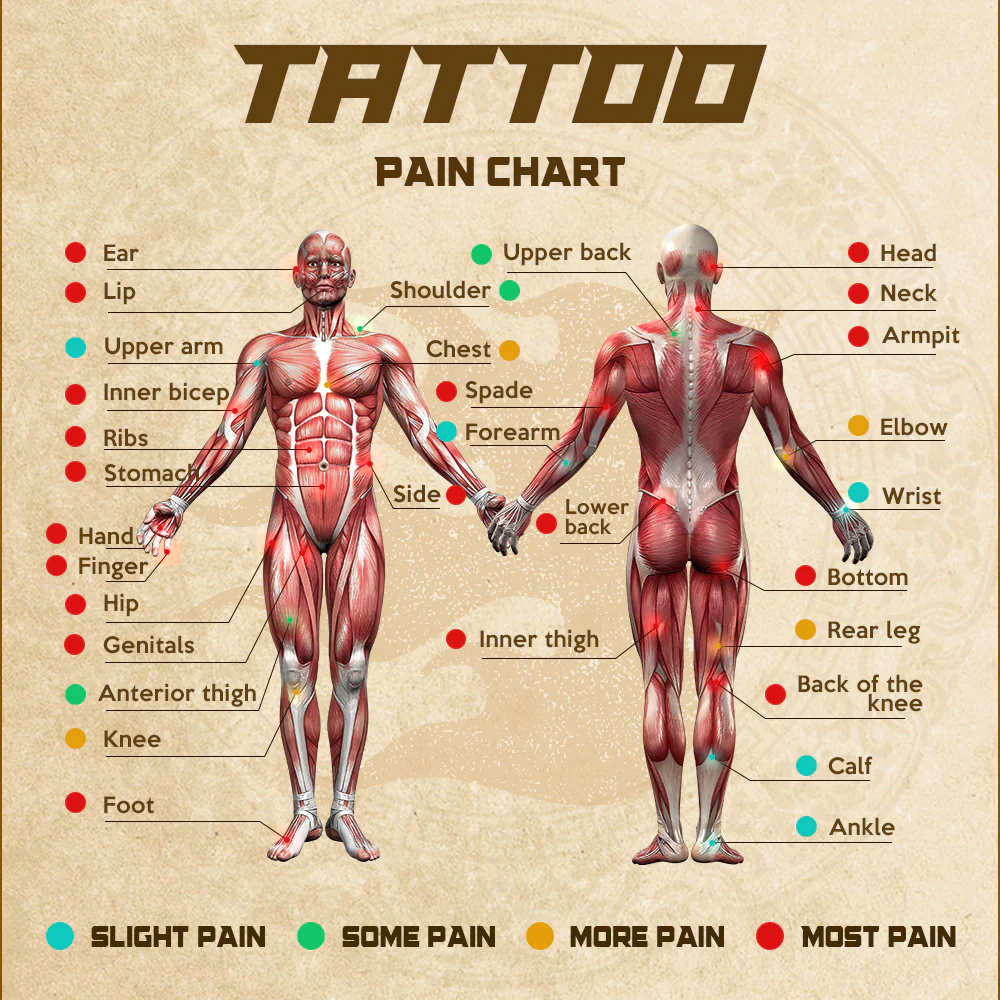Thinking of getting a tattoo but worried about the pain? You’re not alone. One of the most common questions people ask before getting their first (or next) tattoo is, “How much is it going to hurt?” The answer depends on several factors—but primarily, it comes down to where on your body you’re getting inked.
This guide will break down the most and least painful tattoo spots on the body, why certain areas hurt more, and how you can prepare for the discomfort. Let’s dive in.
Understanding Tattoo Pain: Why It Happens
Tattooing involves puncturing the skin with a needle to deposit ink into the dermis (the second layer of skin). This process naturally causes pain, but the intensity can vary depending on your:
- Pain tolerance
- Body fat and muscle in the area
- Skin thickness
- Nerve endings near the tattoo site
Some areas are packed with nerves and close to bones—these typically hurt the most. Other spots with more flesh and fewer nerves tend to be less painful.
Most Painful Tattoo Spots
Here’s a list of areas that are commonly considered the most painful for tattoos:
1. Rib Cage
The ribs are notoriously painful because there’s little fat or muscle padding the bones. Each breath can make the pain feel even worse.
2. Spine
Getting tattooed along the spine means needles are working right over your central nervous system. The vibrations and proximity to bone make this area especially intense.
3. Armpits
There are lots of nerve endings in the armpit, and the thin, soft skin makes this a highly sensitive spot.
4. Elbows and Knees (Inner and Outer)
These joints are tough to tattoo and often require multiple passes. The skin here is thick but right over bone and cartilage, which can make it burn or throb.
5. Neck and Throat
The neck has thin skin and is full of nerves. Vibrations from the tattoo machine can add to the discomfort.
6. Face and Head
Tattoos on the face, temples, or scalp are painful due to nerve density and minimal padding. Some people even get headaches during or after the process.
7. Hands and Fingers
There’s not much cushioning on the hands and fingers, and tattooing here can also be ticklish and painful. These areas fade quickly, too.
8. Feet and Toes
The skin on the feet is thin, and there’s not much between the skin and bone. Plus, your feet are constantly moving and exposed to friction during healing.
Least Painful Tattoo Spots
If you’re looking for a smoother first-time tattoo experience, consider these less painful areas:
1. Outer Upper Arm
This spot has good muscle and fat, and fewer nerve endings compared to other parts of the body.
2. Forearm
A popular place for tattoos, the forearm is relatively low on the pain scale and heals well.
3. Shoulders
Like the upper arm, the shoulder has thick skin and muscle, making it easier to handle.
4. Calves
With plenty of muscle and not a lot of nerve endings, the calves are a good spot for larger tattoos with less pain.
5. Thighs (Outer)
Outer thighs have lots of fat and muscle, making them one of the least painful tattoo locations. Inner thighs, however, can be much more sensitive.
6. Buttocks
If you’re not shy, the butt is surprisingly low on pain thanks to all the padding.
Factors That Affect Tattoo Pain
Beyond the location, a few other things can influence how much pain you feel:
- Tattoo Size & Detail: Larger or more detailed pieces take longer and may involve multiple needles or sessions.
- Tattoo Artist’s Technique: Some artists have a gentler hand than others.
- Skin Sensitivity: Some people naturally have more sensitive skin or conditions like eczema that make tattooing more painful.
- Your Mental State: Anxiety or lack of sleep can make you more sensitive to pain.
How to Manage Tattoo Pain
Even if you’re getting inked in a painful spot, there are ways to reduce discomfort:
- Eat Before Your Session: A full stomach stabilizes blood sugar levels and helps reduce nausea.
- Stay Hydrated: Drink water before and after your session.
- Avoid Alcohol and Caffeine: These can thin your blood and increase sensitivity.
- Take Deep Breaths: Focus on calm breathing during painful moments.
- Use Numbing Cream (If Allowed): Some artists may permit numbing creams or sprays, but ask first.
Should You Let Pain Decide Tattoo Placement?
Not necessarily. While pain is a real factor, it shouldn’t stop you from getting the design you love in the perfect place. Many people say the pain is worth it, and the discomfort fades, but the tattoo is forever.
Plan your tattoo around your lifestyle, desired visibility, and personal meaning. If pain is a major concern, start with a smaller tattoo in a low-pain area and work your way up.
Tattoo Aftercare and Pain
Pain doesn’t stop when the tattoo is finished. Healing can bring its own discomfort:
- Itching and Tightness: As your tattoo heals, it may itch or feel dry.
- Peeling: This is normal but should not be scratched.
- Swelling or Redness: Temporary and common—use cold compresses if needed.
Follow your artist’s aftercare instructions to avoid infection and reduce prolonged pain.
Pain is a part of the tattoo process, but it’s not the whole story. Knowing what to expect and preparing your body and mind can make the experience much more manageable.
Whether you’re going for a meaningful piece on your ribs or testing the waters with a forearm design, understanding tattoo pain spots helps you make informed decisions.
In the end, every tattoo tells a story—including the one about how you braved the needle.

